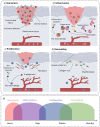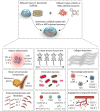Biomimetic scaffolds loaded with mesenchymal stem cells (MSCs) or MSC-derived exosomes for enhanced wound healing
- PMID: 39522032
- PMCID: PMC11549779
- DOI: 10.1186/s13287-024-04012-8
Biomimetic scaffolds loaded with mesenchymal stem cells (MSCs) or MSC-derived exosomes for enhanced wound healing
Abstract
Since wound healing is one of the most important medical challenges and common dressings have not been able to manage this challenge well today, efforts have been increased to achieve an advanced dressing. Mesenchymal stem cells and exosomes derived from them have shown high potential in healing and regenerating wounds due to their immunomodulatory, anti-inflammatory, immunosuppressive, and high regenerative capacities. However, challenges such as the short life of these cells, the low durability of these cells in the wound area, and the low stability of exosomes derived from them have resulted in limitations in their use for wound healing. Nowadays, different scaffolds are considered suitable biomaterials for wound healing. These scaffolds are made of natural or synthetic polymers and have shown promising potential for an ideal dressing that does not have the disadvantages of common dressings. One of the strategies that has attracted much attention today is using these scaffolds for seeding and delivering MSCs and their exosomes. This combined strategy has shown a high potential in enhancing the shelf life of cells and increasing the stability of exosomes. In this review, the combination of different scaffolds with different MSCs or their exosomes for wound healing has been comprehensively discussed.
Keywords: Exosome; Mesenchymal stem cell; Scaffold; Tissue engineering; Wound healing.
© 2024. The Author(s).
Conflict of interest statement
The authors declare that they have no competing interests.
Figures




Similar articles
-
Application of Mesenchymal Stem Cells and Exosome alone or Combination Therapy as a Treatment Strategy for Wound Healing.Cell Biochem Biophys. 2024 Dec;82(4):3209-3222. doi: 10.1007/s12013-024-01448-w. Epub 2024 Jul 28. Cell Biochem Biophys. 2024. PMID: 39068609 Review.
-
Collagen sponge scaffolds loaded with Trichostatin A pretreated BMSCs-derived exosomes regulate macrophage polarization to promote skin wound healing.Int J Biol Macromol. 2024 Jun;269(Pt 2):131948. doi: 10.1016/j.ijbiomac.2024.131948. Epub 2024 Apr 28. Int J Biol Macromol. 2024. PMID: 38688338
-
Chitosan Hydrogel Dressing Loaded with Adipose Mesenchymal Stem Cell-Derived Exosomes Promotes Skin Full-Thickness Wound Repair.ACS Appl Bio Mater. 2024 Feb 19;7(2):1125-1134. doi: 10.1021/acsabm.3c01039. Epub 2024 Feb 6. ACS Appl Bio Mater. 2024. PMID: 38319146
-
In Vitro Assessment of Chitosan-PEG Hydrogels Enriched with MSCs-Exosomes for Enhancing Wound Healing.Macromol Biosci. 2025 May;25(5):e2400609. doi: 10.1002/mabi.202400609. Epub 2025 Jan 21. Macromol Biosci. 2025. PMID: 39838702 Free PMC article.
-
Revolutionizing dermatology: harnessing mesenchymal stem/stromal cells and exosomes in 3D platform for skin regeneration.Arch Dermatol Res. 2024 May 25;316(6):242. doi: 10.1007/s00403-024-03055-4. Arch Dermatol Res. 2024. PMID: 38795200 Free PMC article. Review.
Cited by
-
Engineering strategies to enhance the research progress of mesenchymal stem cells in wound healing.Stem Cell Res Ther. 2025 Jul 1;16(1):342. doi: 10.1186/s13287-025-04471-7. Stem Cell Res Ther. 2025. PMID: 40598499 Free PMC article. Review.
-
Skin regenerative potential of hydrogel matrices incorporated with stem cell-derived extracellular vesicles enriched with MicroRNAs: a systematic review.Mol Cell Biochem. 2025 Jul;480(7):4035-4067. doi: 10.1007/s11010-025-05248-5. Epub 2025 Mar 17. Mol Cell Biochem. 2025. PMID: 40090986
-
Synergistic effects of mesenchymal stem cells and their secretomes with scaffolds in burn wound healing: a systematic review and meta-analysis of preclinical studies.J Transl Med. 2025 Jul 1;23(1):708. doi: 10.1186/s12967-025-06712-y. J Transl Med. 2025. PMID: 40598532 Free PMC article. Review.
References
-
- Dong R, Guo B. Smart wound dressings for wound healing. Nano Today. 2021;41:101290.
Publication types
MeSH terms
LinkOut - more resources
Full Text Sources

